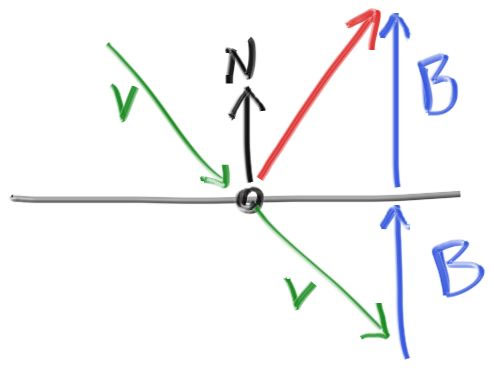다른 재질을 시도해볼 차례입니다. Material 추상 클래스를 이용해서 캡슐화할 겁니다. Material은 다음 두가지 기능이 필요합니다.
- 광선 생산
- 반사된 광선 약화
data Material =
forall a. Scatterable a =>
Material a
data Scattered =
Scattered
{ scatteredRay :: Ray
, attenuationColor :: Vec3 Float
}
class Scatterable a where
scatter :: (RandomGen g) => a -> Ray -> HitRecord -> g -> (Maybe Scattered, g)
Material and HitRecord
hitRecord 와 Material 은 서로를 참고하기 때문에, circular import problem이 발생할 수 있습니다. 하스켈에서는 같은 모듈안에 있기만 하다면 별다른 문제가 발생하지 않기 때문에 넘어가겠습니다.
광선이 물체의 표면에 부딪혔을 때, hitRecord에 재질을 저장합니다. ray_color() 함수에서 Material 을 알아낼 수 있습니다.
data HitRecord =
HitRecord
{ hitPoint :: Point
, hitNormal :: Vec3 Float
, hitT :: Float
, hitFrontFace :: Bool
, hitMaterial :: Material
}
data Sphere =
Sphere
{ sphereCenter :: Point
, sphereRadius :: Float
, sphereMaterial :: Material
}
광선 발산과 반사 구상하기
Lambertian(난반사)는 이미 가지고 있습니다. 광선의 반사도 R와 1 - R로 광선을 흡수할 수도, 두 방법을 섞을 수도 있습니다. 구현은 아래와 같습니다.
선택에 따라 반사율 p와, 반사도(attenuation)를 albedo/p로 둘 수 있습니다.
data Lambertian =
Lambertian
{ albedo :: Color Float
}
instance Scatterable Lambertian where
scatter (Lambertian color) ray (HitRecord p normal _ _ _) g =
(Just (Scattered (Ray p scatterDir) color), g')
where
(randUnitVec, g') = sampleUnitVector g
scatterDir = v = normal + randUnitVec
위 코드를 자세히 보면, 실수를 발견할 수 있습니다. 만약 무작위 단위벡터가 법선과 정반대라면 합이 0 이 되어서, Scatter 광선이 NaN에 빠질 수 있습니다. 이를 검사해야합니다.
scatterDir =
let v = normal + randUnitVec
in if vNearZero v
then normal
else v
거울 반사
매끄러운 메탈 재질은 광선을 무작위적으로 뿌리지 않습니다.

반사되는 광선(빨간색): $v + 2b$, n은 단위벡터지만, v는 아마 아닙니다. b의 길이는 $v \cdot n$입니다.
vReflect :: Num a => Vec3 a -> Vec3 a -> Vec3 a
vReflect v n = v - pure (2 * vDot v n) * n
data Metal =
Metal
{ albedo :: Color Float
}
instance Scatterable Metal where
scatter (Metal color) ray (HitRecord p normal _ _ _) g
| 0 < vDot (direction scatterRay) normal =
(Just (Scattered scatterRay color), g)
| otherwise = (Nothing, g)
where
reflected = vReflect (vUnit . direction $ ray) normal
scatterRay = Ray p reflected
ray2color ::
(Ord t, RandomGen p, Num t, Hittable a)
=> a
-> p
-> t
-> Ray
-> (Vec3 Float, p)
ray2color objs g depth r
| depth <= 0 = (Vec3 0 0 0, g)
| isNothing hr = (backgroundRayColor, g)
| otherwise = hitRecursively (fromJust hr) g
where
hr = hit objs r (HitRange 0.001 maxValue)
backgroundRayColor =
let t' = 0.5 * ((+ 1) . _y . vUnit . direction $ r)
in pure (1 - t') + pure t' * Vec3 0.5 0.7 1.0
hitRecursively hr@(HitRecord _ _ _ _ (Material m)) g
| isJust _scattered =
let scattered' = fromJust _scattered
attenuation = attenuationColor scattered'
(color, g') =
ray2color objs g1 (depth - 1) (scatteredRay scattered')
in (attenuation * color, g')
| otherwise = (Vec3 0 0 0, g)
where
(_scattered, g1) = scatter m r hr g
화면에 구 그리기
spheres =
[ Sphere
(Vec3 0 (-100.5) (-1))
100
(Material (Lambertian (Vec3 0.8 0.8 0)))
, Sphere (Vec3 0 0 (-1)) 0.5 (Material (Lambertian (Vec3 0.7 0.3 0.3)))
, Sphere (Vec3 (-1) 0 (-1)) 0.5 (Material (Metal (Vec3 0.8 0.8 0.8)))
, Sphere (Vec3 1 0 (-1)) 0.5 (Material (Metal (Vec3 0.8 0.6 0.2)))
]

퍼지 반사
반사되는 방향에 작은 구를 만들어 그 안의 새로운점을 향하게 만듭니다. 이것으로 무작위 광선을 만들 수 있습니다.

구가 더 커질수록, 더 무작위하게 튑니다. 이것은 fuzzniess값으로 조절할 수 있습니다.
data Metal =
Metal
{ albedo :: Color Float
, fuzz :: Float
}
instance Scatterable Metal where
scatter (Metal color f) ray (HitRecord p normal _ _ _) g
| 0 < vDot (direction scatterRay) normal =
(Just (Scattered scatterRay color), g)
| otherwise = (Nothing, g)
where
(randUnitSphere, g') = sampleUnitSphere g
reflected = vReflect (vUnit . direction $ ray) normal
scatterRay = Ray p (reflected + (pure . min 1 $ f) * randUnitSphere)
spheres =
[ Sphere
(Vec3 0 (-100.5) (-1))
100
(Material (Lambertian (Vec3 0.8 0.8 0)))
, Sphere (Vec3 0 0 (-1)) 0.5 (Material (Lambertian (Vec3 0.7 0.3 0.3)))
, Sphere (Vec3 (-1) 0 (-1)) 0.5 (Material (Metal (Vec3 0.8 0.8 0.8) 0.3))
, Sphere (Vec3 1 0 (-1)) 0.5 (Material (Metal (Vec3 0.8 0.6 0.2) 1.0))
]
PREVIOUS(RayTracing) 난반사 재질
NEXT(RayTracing) 유전체